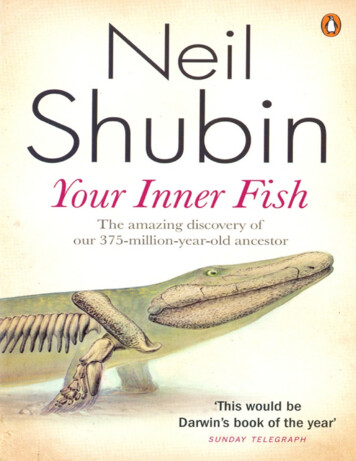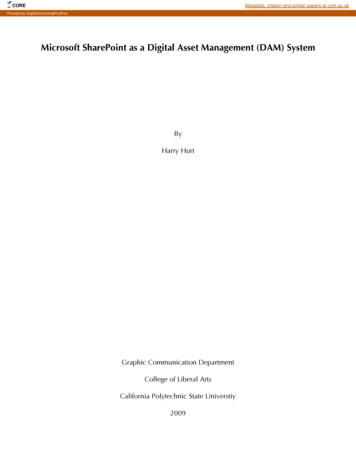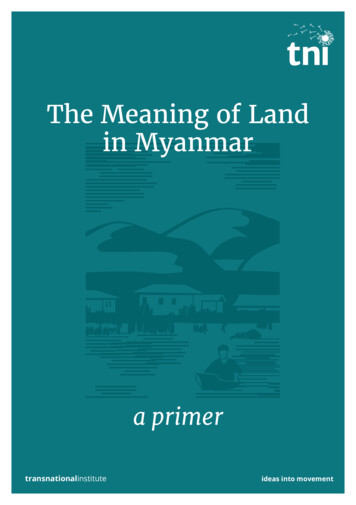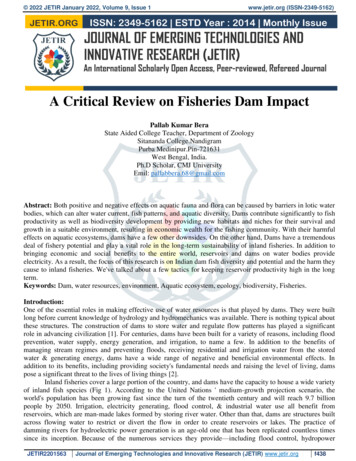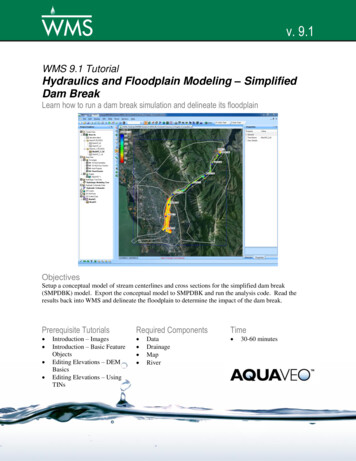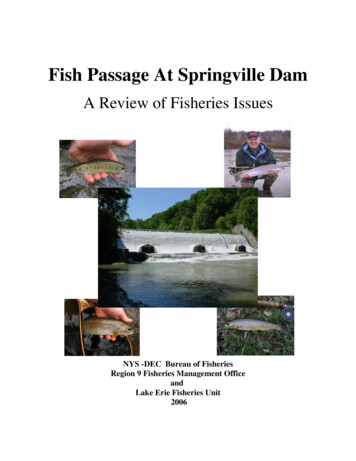
Transcription
Fish Passage At Springville DamA Review of Fisheries IssuesNYS -DEC Bureau of FisheriesRegion 9 Fisheries Management OfficeandLake Erie Fisheries Unit2006
Table of ower Cattaraugus Creek (below Springville Dam).3Upper Cattaraugus Creek (above Springville Dam).3Fish Community Changes.4Resident brook, brown trout and rainbow trout.5Projected Wild Steelhead Production.7Sea lamprey.8Other Fish Species.8Disease issues.8Contaminants .9Economic Considerations.9Social Considerations.9Angler preferences.10Public access.10Fisheries Regulations.10Ecological Benefits.10Future Research Opportunities.11Issue Summary.11Literature cited.13Table 1. Stream mileage and public fishing on the lower CattaraugusCreek System (below Springville Dam).16Table 2. Stream mileage and public fishing on the upper CattaraugusCreek System (above Springville Dam).17Table 3. List of fish species found in the lower Cattaraugus Creek system.19Table 4. List of fish species found in the upper Cattaraugus Creek system.21Figure 1. Lower Cattaraugus Creek system public access.22Figure 2. Upper Cattaraugus Creek system public access.23Figure 3. Upper Cattaraugus Creek system-where wild resident trout are present.24Introduction-1-
This document reviews issues related to fish passage over Springville Dam and inparticular, those associated with passage of lake-run steelhead trout to the upper CattaraugusCreek system.Cattaraugus Creek flows from its headwaters at Java Lake in Wyoming County for 65miles to Lake Erie. The stream has a drainage area of approximately 280 square miles.Springville Dam, a 40 foot high, 338 foot long structure built in 1922, is located 34 miles abovethe mouth and is impassable to fish. The dam has not generated electricity since 1998 and iscurrently maintained by Erie County as a recreational park. The US Army Corps of Engineers inpartnership with NYS-DEC is currently evaluating the feasibility of fish passage at SpringvilleDam.During the last 20 years a high quality lake-run steelhead fishery has developed inCattaraugus Creek from the mouth to Springville Dam (hereafter referred to as lowerCattaraugus Creek). This fishery is supported by the stocking of steelhead smolts, although anestimated 25% of adult fish returning to the creek are of wild origin (Mikol 1976, Goehle 1998).Due to heavy siltation and high summer water temperatures, little successful spawning occurs inthe main stream. Approximately 27 miles of tributary below Springville Dam provide steelheadspawning and nursery habitat (Table 1).Public access for angling on the lower 34 miles of Cattaraugus Creek is limited (Table 1,Figure 1). Most of the lower 20 miles of the stream are within the Seneca Nation of Indians(SNI) Cattaraugus Reservation where fishing by non-Native Americans requires a SNI fishinglicense. Approximately 4 miles of public fishing rights easements (PFR) exist along lowerCattaraugus Creek and eight miles of the main stream and the South Branch are under NYSDECjurisdiction (Zoar Valley Multiple Use Area). Access to the creek within the Zoar Valley MUAis considered challenging since much of it flows within a deeply incised gorge (Table 1, Figure1). Lower Cattaraugus Creek is turbid during much of the time steelhead are in the stream(September-May) due to the abundance of clay soils and highly unstable, erodible banks.From Springville Dam upstream (hereafter referred to as upper Cattaraugus Creek),NYSDEC maintains 34 miles of PFR easements (Table 2, Figure 2). From river mile (RM) 46,near the mouth of Elton Creek upstream to Java Lake, the creek runs clear most of the year,providing ideal trout angling conditions. NYSDEC annually stocks 18.2 miles (RM 40 to RM58) along the main branch of upper Cattaraugus Creek and 6.2 miles of Elton Creek withyearling and two year old brown trout. Approximately 17 miles of the main stream and anadditional 27 miles of several tributaries support abundant, fishable populations of wild, residentbrown and rainbow trout. Relict populations of native brook trout occur in 15 headwater streamsections (Figure 3). At least 30 additional miles of smaller tributaries provide spawning andnursery habitat for wild trout populations (Table 2, Figure 3).Sportfisheries-2-
Lower Cattaraugus CreekThe sportfishery below Springville Dam is supported by lake-run steelhead, brown troutand a few chinook salmon (chinook salmon are no longer stocked in Lake Erie). Sportfisheriesalso exist for smallmouth bass, walleye and channel catfish. Other fishes such as rainbow smelt,suckers, redhorse, carp, minnows, dace, shiners, darters, white perch, yellow perch and bullheadare found below the dam, mainly in the lower 5 miles (Table 3). Steelhead support the mostpopular tributary sportfishery and have brought it international recognition (Markham 2006).Steelhead enter Cattaraugus Creek in early September and leave as late as June, providing afishery lasting almost ten months. The peak of the fishery occurs in October and November,usually in the lower sections of the stream on the SNI lands. Steelhead migrate upstream 34miles to Springville Dam (the first barrier impassable to fish) and many spawn in smallertributaries. The lower creek is annually stocked with 90,000 “Washington strain” steelheadyearlings but studies indicate that naturally produced fish comprise about 25% of the adultsreturning to the creek (Mikol 1976, Goehle 1998). Angler effort compiled from recent creelsurveys (2003-2005) showed that Cattaraugus Creek received the most angling effort forsalmonids in both sampling years (27,649 and 56,574 angler trips, respectively) of any NewYork, Lake Erie tributary. Catch rates of salmonids were also very high at 0.41 fish/hour in2003-04 and 0.56 fish/hour in 2004-05. Estimated total catch ranged from 30,303 to 55,112 troutand salmon (Markham 2006).Several tributaries of Cattaraugus Creek below Springville Dam have abundant juvenilesteelhead (Table 1). High densities of age 0 through age 3 steelhead/rainbows are found inSpooner Brook (NYSDEC, Lake Erie Fisheries Unit file data). It is unclear whether these age-2and age-3 fish are steelhead that remain in the tributaries for additional years before droppinginto Lake Erie, or if they are the resident strain, spending their entire life cycle in the stream.Similar populations occur in other Lake Erie tributaries as well (Eighteen Mile Creek,Canadaway Creek, Chautauqua Creek, Twenty Mile Creek).Upper Cattaraugus CreekIn the first 15 miles above Springville Dam, the predominant fish species are whitesucker, northern hog sucker, river chub, common shiner, creek chub, longnose dace, blacknosedace, central stoneroller and stonecat (Table 4). A few stocked brown trout, wild brown troutand wild rainbow trout are found in this section, although their numbers are limited by warmsummer water temperatures (Region 9 fisheries file data).From Elton Creek (RM 46) upstream to East Arcade (RM 58), Cattaraugus Creeksupports a fishery for wild rainbow trout (360 adults/mile), wild brown trout (280 adults/mile)and stocked brown trout (Evans 2006). Other fish species present in this section include whitesucker, northern hog sucker, blacknose dace, longnose dace, redside dace, central stoneroller,rainbow darter, fantail darter, common shiner, bluntnose minnow, mottled sculpin and greensunfish (Table 4) (Evans 2006). In the remaining 7 miles upstream to Java Lake some wildbrown trout are found with the same general fish assemblage found in the previous section and a-3-
few warmwater species that have moved downstream from Java Lake (Table 4) (Region 9fisheries file data). Little or no successful trout spawning occurs in the main stem of CattaraugusCreek due to excessive siltation. Wild trout occurring there are likely migrants from tributaries.Fishing pressure on the stocked portion of upper Cattaraugus Creek (18.2 miles) isconsidered high with an estimated 880 hours/acre of angling (15,488 angler trips). Thirty-ninepercent of this effort occurred in April (Evans 1998). Pressure on the four unstocked wild trouttributaries was lower, ranging from 282 hours/acre on Clear Creek (Arcade) to 135 hours/acre onMcKinstry Creek. Total estimated angler effort for the four streams was 2,865 angler trips(Cornett 2006).Brown trout have been stocked in the upper Cattaraugus Creek system since the early1900s. They were established in many tributary streams such as Lime Lake Outlet and ClearCreek by 1928 (New York State Conservation Department 1929). Rainbow trout stockingrecords in the Wyoming County portion of Cattaraugus Creek and Cheney Brook in the ClearCreek watershed go back as far as 1882 . Wild rainbow trout were well established in EltonCreek by 1928. These strains were similar to the short-lived strain of rainbow trout currentlyfound in the upper Cattaraugus Creek system and reach a maximum age of four years and amaximum size of 9-12 inches (New York State Conservation Department 1929). Wild browntrout in upper Cattaraugus Creek live six years or more and may reach a maximum size of 24inches, although fish greater than 18 inches are rare (Cornett 2006). In the tributary streams thathave been extensively studied (Clear Creek, Lime Lake Outlet, Hosmer Brook and McKinstryCreek), trout populations are at or near carrying capacity for trout (Cornett 2006).Fish Community ChangesIf steelhead pass upstream of Springville Dam they would have access to more than 75additional miles of fishable stream and over 50 miles of high quality spawning and nurseryhabitat currently containing “resident” wild brown and rainbow trout populations (Table 2).Brown trout, native to Europe but introduced to watersheds across New York State, is the mostwidespread of the two species in the upper Cattaraugus Creek system. Rainbow trout, native tothe Pacific Coast drainages from California to Alaska, occur in two life-history forms, theresident (non-migratory) rainbow trout and the potamodromous (lake-run) steelhead. Both forms(Oncorhynchus mykiss) are indistinguishable from each other physically and perhaps evengenetically in their early life (Behnke 2002). The origin of the upper Cattaraugus Creek/residentrainbow trout strain remains unclear due to early mixing of hatchery stocks (Behnke 2002). Theonly salmonid native to the Cattaraugus Creek system is the brook trout. It inhabits 15 smallstreams in the system and in only one stream, Spring Brook (Springville), are they the lonesalmonid. Spring Brook has a barrier that would block migration of steelhead and other fishspecies.Resident Brook, Brown and Rainbow Trout-4-
Studies examining interactions between resident, wild brown trout, brook trout andintroduced steelhead in the Great Lakes have provided interesting and sometimes conflictingresults (Nuhfer et al. 2005, Kocik and Taylor 1996, Kocik and Taylor 1991, Ziegler 1988, Hearn1987, Kruger 1985, Kruger et al. 1985). In the early 1990s, steelhead gained access toWhiteman’s Creek, a 4th order tributary of the Grand River in Ontario where an abundant wildbrown trout population existed. At the time of the steelhead introduction a study of regulationchanges on the brown trout fishery was underway. Sampling in 1994 in the “no regulationchange” and “regulation change” sections of the river showed that even with steelhead spawning,brown trout populations increased over pre-steelhead values. Anecdotal evidence since 1994showed 2-3 times more steelhead present with no declines in brown trout numbers (Jim Bowlbyand Larry Halyk, Ontario Ministry of Natural Resources, unpublished data). Although browntrout populations have not declined in Whiteman’s Creek, the abundance of yearling steelheadhas forced anglers to change their angling techniques to avoid catching young steelhead. Also, asignificant fishery for wild resident (non-migratory) rainbow trout reaching large size (10-22inches) has developed in the Grand River, downstream of Whiteman’s Creek, perhaps as resultof the steelhead spawning in that stream (Larry Halyk, Ontario Ministry of Natural Resourcespersonal communication).Significant declines in the brown trout fishery in the Pere Marquette River (MI) wereassociated with competition between steelhead parr and brown trout (Kruger et al. 1985). AMichigan DNR research study by Ziegler (1988) found that diets and habitat use of juvenilerainbow and brown trout were similar when found together in a stream, but this overlap did notappear to affect growth of young-of-year of either species. Differences in abundance of browntrout over 8 inches in allopatric (separate) versus sympatric (shared) populations lead researchersto conclude that competition with steelhead adversely affected the abundance of resident browntrout. Kocik and Taylor (1991) studied the survival and growth of age-0 brown trout with andwithout age-0 steelhead in an artificial stream and found that interactions with steelhead did nothave negative effects on brown trout survival or growth. This study was conducted at lowerdensities than what is normally found in Great Lakes tributaries. Competition was minimal ornonexistent when populations were limited by processes other than competition (Hearn 1987).No apparent impacts of age-0 steelhead on age-0 brown trout were found in GilchristCreek, Michigan (Kocik and Taylor 1996). Habitat use at age 0 was similar for both speciesbut there was some vertical habitat separation with young steelhead higher in the water columnand brown trout remaining near the bottom. Researchers hypothesized that the larger size ofbrown trout young-of-year, due to earlier hatching, may have permitted them to compete withthe steelhead progeny. The study concluded that the two species may coexist in low gradientrivers similar to Gilchrist Creek but may not in higher gradient systems.An ongoing study at the Hunt Creek Fisheries Research Station in Michigan, located nearthe Gilchrist Creek system showed different results (Nuhfer et al. 2005). Researchers stockedadult steelhead in a section of Hunt Creek previously inhabited by an abundant wild brown troutpopulation and a small wild brook trout population to measure the effects of steelhead on theresident trout populations. Extensive flow, temperature and trout population data were collected-5-
prior to (1995-1997) and after (1998-2005) steelhead introductions. After steelhead werestocked in Hunt Creek the abundance of yearling and older wild brown trout declined by half.Annual survival of age-0 brown trout declined 23-36% while there was no change in survival ofolder brown trout. In a reference stream (where no steelhead were introduced), there was nochange in brown trout abundance or survival. The mean length of age-2 and age-3 brown troutincreased after steelhead were stocked. This may have been due to the increased number ofyoung-of-year rainbow trout available as forage for the larger brown trout (Cornett 2006).Wild brook trout abundance also declined in Hunt Creek after introduction of steelhead,but their abundance also declined in the reference stream where steelhead were not present(Nuhfer et al. 2005). Interestingly, the fall abundance of young-of-year brown trout did notdecline, indicating steelhead did not impair brown trout spawning success. Apparently, poorover-winter survival to age 1, perhaps from poor condition, lead to lower abundance. Theresearchers further concluded there was likely some mortality to brown trout eggs or sac fry bysteelhead redd superimposition, but they found less than 10% of brown trout redds were affected(Nuhfer et al. 2005). Some investigators have suggested that dense populations of largespawning steelhead could reduce the abundance of brown trout where available spawning areasare limited by dislodging or damaging early life stages during digging of their redds (Seelbach1986; Kocik and Taylor 1991). Redd superimposition by rainbow trout reduced brown troutspawning success by 94% in an experimental section of a New Zealand stream (Hayes 1987).Additional insights into interactions between wild brown trout and rainbow trout(resident strain) were observed in upper Cattaraugus Creek tributaries during extensiveevaluations of a nine-inch minimum size limit. In Clear Creek, wild brown trout abundanceremained stable from 1990 to 2002 while wild rainbow trout abundance increased from less than30 adults/mile to over 460 adults/mile (Cornett 2006). Brown trout populations in these streamsmay have remained stable because of increased predation on age-0 rainbow trout and differentialhabitat selection (Pomeroy 1993, Cornett 2006).In the Smoky Mountains of North Carolina and Tennessee, studies showed thatintroduced rainbow trout displaced wild brook trout from extensive areas of their original range(Larson and Moore 1985, Moore et al. 1983). No quantitative studies have been carried out inthe upper Cattaraugus Creek tributaries where populations of rainbow trout and brook troutcoexist to evaluate interactions between these species. Whether steelhead would negativelyimpact wild brook trout populations in the upper Cattaraugus Creek watershed is unknown. Onlyone brook trout stream (Spring Brook, Springville) in the upper Cattaraugus Creek system isisolated from resident brown and rainbow trout populations and this stream has a natural barrierto prevent upstream migrations by steelhead.Information is lacking regarding interactions between steelhead and resident rainbowtrout in the Great Lakes Region but Bjornn (1978) evaluated impacts of stocking steelhead intoBig Springs Creek in Idaho. He found that 13 years after steelhead had been stocked, residentrainbow trout abundance was reduced by approximately 60%. The causal agent for thisreduction may have been out-migration of resident rainbows greater than age 1 due to-6-
intraspecific (within species) competition. Juvenile steelhead and resident rainbows sharedvirtually identical habitat requirements and in coastal Washington streams with establishedsteelhead populations, resident rainbow populations were rare or non-existent (Hunter 1989).Steelhead progeny seemed to out-compete resident rainbow trout but no competitive criteriawere identified.The steelhead’s higher fecundity may assist it in competitive interactions with residentrainbow trout. Barnhart (1991) reported that a 20 inch female steelhead produced 3,500 eggswhile a 10 inch resident rainbow trout may only produce 500 eggs. Depending on the densitiesof both steelhead and resident spawners, steelhead may out-produce resident rainbows by 85%.The sheer numbers of steelhead progeny produced could provide an advantage over the residentrainbow trout. Steelhead populations are very productive at low spawner abundance where thereis little or no density-dependent competition for food and space by juveniles (Ward 2006).Steelhead have a highly diverse life history with the number of years spent in their natalstreams varying from one to five years based on available food and space (Ward 2006). If somesteelhead progeny in the upper Cattaraugus system do not migrate to Lake Erie, these fish mightprovide a fishery similar the Grand River, Ontario where rainbow trout up to 22 inches werecaught through the summer months (Larry Halyk, Ontario Ministry of Natural Resources,personal communication). Some of the steelhead/rainbow trout now produced in streams such asSpooner Brook, Chautauqua Creek and 20 Mile Creek stay in those streams until they are age 3(9-11 inches) providing a sportfishery comparable to that found in the upper Cattaraugus duringthis extended residence time. In 2002, a survey of wild resident rainbow trout in Clear Creekshowed that of the rainbow trout age 1 and older, 82% were yearlings, 13% were two year oldsand 5% were three year olds (Cornett 2006). Age distributions for Clear Creek (upperCattaraugus Creek) and Spooner Brook (lower Cattaraugus Creek) were similar.Projected Wild Steelhead ReproductionWhile it is difficult to project wild steelhead production in the upper Cattaraugus Creeksystem if steelhead passage occurred at Springville Dam, expansion of known production levelsfrom Spooner Brook (lower Cattaraugus Creek) could provide some insight into potentialproduction. The estimated number of young-of-year produced in Spooner Brook in 2001 was4,261/mile (Lake Erie Fisheries Unit, file data). Expansion of that value by the estimatednumber of tributary miles above Springville Dam (57 miles), resulted in the production of240,000 wild, young-of-year steelhead in the upper Cattaraugus Creek system. High numbers ofsteelhead young-of-year can be produced even at low spawner abundance but numbers of youngof-year steelhead produced may not translate directly into numbers of steelhead smolts producedor numbers of returning adults at maturity (Ward 2006).Sea LampreySea lamprey entered Lake Erie in the 1920s with the opening of the Welland Canal butwere not considered a major fisheries concern until restoration of native lake trout began in thelate 1970s. Control of lamprey spawning in Great Lakes tributaries remains the primary focus of-7-
the Great Lakes Fishery Commission with expenditures on Cattaraugus Creek alone exceeding 200,000 per treatment. Cattaraugus Creek is one of the largest producers of sea lamprey onLake Erie. Treatment of this stream from Springville Dam downstream occurs on a three-yearcycle and requires almost a week to complete due to its large drainage area. Springville Damstops the migration of lamprey from entering the upper watershed where 30 miles of primelamprey spawning and rearing habitat exist. Removal of this barrier would open access to theseareas, making lamprey treatment difficult if not impossible and adding millions of dollars to thetreatment costs. Fish ladders can be easily modified to prohibit passage of lamprey whileallowing other fish species such as steelhead to pass upstream. An example of such a lampreybarrier exists on Spooner Brook just downstream from County Route 39 in Erie County. Flowsdirected through the fish ladder could be used to attract lamprey into assessment traps forsubsequent estimation of population size. The Springville Dam trap catch was the primary toolfor determining relative abundance of lamprey in Lake Erie until the power house was shut downin 1998, terminating attraction flows. The establishment of a fish ladder with attraction flowswould restore and perhaps improve upon this valuable assessment tool.Other Fish SpeciesLimited information exists regarding the impact of steelhead on fish species other thansalmonids. It is unlikely that the seasonal occupation of upper Cattaraugus Creek by steelhead,which do not feed extensively during spawning runs, would significantly impact other fishspecies. Indirect affects associated with a reduction in resident trout may occur. Some speciescurrently restricted to the lower creek may migrate upstream, thereby enhancing the systems fishcommunity connectivity.Fish DiseasesSeveral harmful fish diseases have been verified from the Great Lakes and fish passagemay permit upstream transport of these diseases. Great Lakes Fish Health Committee "programpathogens"; heterosporosis, bacterial kidney disease (BKD) and infectious pancreatic necrosis(IPN) have been found in the Great Lakes but not in the inland trout populations of New YorkState. Of the aforementioned diseases, IPN is of greatest concern and has routinely andconsistently been isolated from Lake Erie steelhead during Pennsylvania hatchery brood stockcollections. Nuhfer et al (2005) in the study of steelhead introductions into Hunt Creek, foundthat steelhead carried BKD into the formerly uninfected system.-8-
ContaminantsThere are currently no health advisories that apply specifically to consuming fish fromLake Erie or Cattaraugus Creek below Springville Dam.Economic ConsiderationsThe economic impact of lower Cattaraugus Creek’s steelhead fishery has not beendirectly measured but can be estimated from comparable steelhead fisheries in Ohio andPennsylvania. A Sea Grant study of anglers fishing Ohio tributaries from October 2002 throughApril 2003 determined that the average angler spent 26 per trip (Kelch et al. 2004). Assumingthat angler expenses per trip in Ohio were similar to angler expenses in New York, the estimatedexpenditures for lower Cattaraugus Creek in 2004-05 totaled 1.47 million (56,574 trips X 26/trip). Estimates from Pennsylvania creel surveys using the IMPLAN model (Murray andShields 2004) showed that out-of-county residents spent 61.27/trip while local anglers spent 6.60/trip. Assuming that angler expenses per trip in New York were similar to Pennsylvania,expenditures for lower Cattaraugus Creek in 2004-05 totaled 971,000 (Markham 2006).Expansion of this fishery to the upper Cattaraugus Creek watershed and development of asportfishery targeting wild steelhead would substantially increase the economic potential of thisfishery.The economic value of the existing fishery in the upper Cattaraugus Creek system wasestimated by multiplying the number of trips on Cattaraugus Creek (15,488) (Evans 1998), ClearCreek, Lime Lake Outlet, McKinstry Creek and Hosmer Brook (2,865 trips combined) (Cornett2006) by the aforementioned dollar values spent per trip. Total expenditures derived fromPennsylvania’s trip values were 314,771. If the value per trip in Ohio of 26/trip (Kelch et al.2004) was multiplied by the total estimated angler trips (18,353), the upper Cattaraugus Creekfishery would be worth a minimum value of 477,178. Neither estimate included angler tripsspent on Elton Creek, a popular stocked stream.Social ConsiderationsBenefits gained from passage of steelhead at Springville dam include expansion of thefishery into more accessible and “fishable” habitat and increased angling opportunities for thisspecies. Steelhead have become the most popular sportfish in the tributaries of Lake Erie sincethis fishery expanded over the past decade. Because of its growing popularity, the expansion ofthe steelhead fishery to the upper Cattaraugus should result in increased angler activity overexisting levels. Negative effects of steelhead passage may include angler crowding at preferredsites (Murray and Shields 2004), unethical behavior, overlaps in use with inland trout anglers,the need for increased law enforcement, posting of private property and a need for more/largerangler access facilities.-9-
Angler PreferencesA survey of 161 anglers at the Hamburg Sportsman’s Show (Erie County) in March 2006provided insight into angler preferences in Western New York. Seventy-three percent ofrespondents favored, or slightly favored passing steelhead to the upper Cattaraugus Creeksystem. Fourteen percent slightly opposed or opposed it, while 13% were neutral on the subject.The majority of anglers (76%) in the survey identified themselves as anglers who fished GreatLakes tributaries for steelhead exclusively or who fished both the Great Lakes tributaries andinland trout streams. Of the anglers who said they only fished inland trout streams, 55% slightlyfavored or favored steelhead passage, while only 21% slightly opposed or opposed steelheadpassage (NYSDEC Lake Erie Fish Unit, unpublished data).Public accessCurrently, NYSDEC-public fishing easements (34 miles) and parking areas (15) areadequate for angler use on the upper Cattaraugus Creek system. Steelhead passage at SpringvilleDam would likely increase angling use, increasing the need for additional parking lots and/orexpansion of existing lots. Since steelhead angling occurs from fall through spring, the morepopular parking lots would benefit from maintenance during the winter months. NYSDECcurrently has no public fishing easements on the 12 miles of Cattaraugus Creek from SpringvilleDam upstream to Elton Creek. If steelhead passage at Springville Dam occurred, public fishingeasements on this section of stream would be particularly desirable.Fisheries RegulationsCurrently, four streams in the upper Cattaraugus Cre
partnership with NYS-DEC is currently evaluating the feasibility of fish passage at Springville Dam. During the last 20 years a high quality lake-run steelhead fishery has developed in Cattaraugus Creek from the mouth to Springville Dam (hereafter referred to as lower Cattaraugus Creek). This fishery is supported by the stocking of steelhead .

